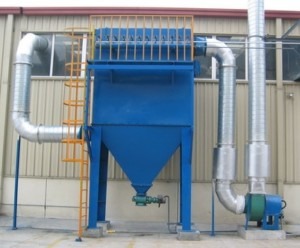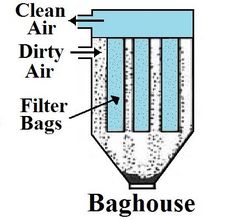A baghouse, or fabric collector, is the generic name for an air pollution-control device designed to filter dust and other fine particles from contaminated air in commercial and industrial facilities. Baghouses provide clean air for employees and customers, protect the environment of nearby equipment, and lessen the plant’s contribution to outdoor air pollution.
 Baghouses control the emission of air pollutants in many industries, such as steel and foundry operations, power plants, chemical production, food manufacturing, and pharmaceutical plants. They came into use in the 1970s upon the development of fabrics that could withstand the high temperatures of dusty industrial gases. Collecting this dust is important because it can be harmful if inhaled, and it may even fuel a deadly explosion. (Read CCPIA’s article on dust inspection to find out more about the potential hazards of dust.) Other commercial and industrial air-filtration devices include electrostatic precipitators, unit collectors, wet scrubbers and inertial separators.
Baghouses control the emission of air pollutants in many industries, such as steel and foundry operations, power plants, chemical production, food manufacturing, and pharmaceutical plants. They came into use in the 1970s upon the development of fabrics that could withstand the high temperatures of dusty industrial gases. Collecting this dust is important because it can be harmful if inhaled, and it may even fuel a deadly explosion. (Read CCPIA’s article on dust inspection to find out more about the potential hazards of dust.) Other commercial and industrial air-filtration devices include electrostatic precipitators, unit collectors, wet scrubbers and inertial separators.
Baghouses operate by the following process:
- Dust-laden air is pulled through ductwork where it enters the hopper, which is a large funnel-shaped container.
- The air is then drawn through a collection of cylindrical bags and expelled to the outdoors through an exhaust stack.
Dust and other particles too large to pass through the bags will accumulate on the bags’ surfaces and form a layer known as a dust cake, which thickens and slows the rate that gas can enter the bags. This resistance to air flow, known as pressure drop, will eventually prevent any air from entering the bags, at which point the dust cake must be removed before normal operation can continue. Dust-cake removal processes can be divided into distinct methods, which are, in turn, used to categorize the types of baghouses.
The four most common designs include:

- the pulse-jet system, in which compressed air causes rapid expansion of the bag’s fabric, shattering the dust cake and forcing it from the bag. This “self-cleaning” type of baghouse is the most popular because it does not interfere with the inflow of dust-laden air and allows for continuous operation while cleaning is taking place;
- the reverse-air system, in which the dust cake is removed by the combined forces of an inflow of clean air in the reverse direction (opposite that of the dust-laden air) with the collapse of the bag, which results from a partial shutdown of normal air flow;
- the shaker system, in which the bag is physically shaken in order to remove the dust cake. A rod driven by a motor shakes the bag in a horizontal direction while normal operation of the baghouse temporarily ceases; and
- the sonic system, in which vibration caused by a low-frequency sound generator removes the dust cake. This method is sometimes used in combination with other methods.
Inspection and repair of baghouse components are required to ensure that the system functions as designed. Inspection procedures can differ considerably based on the design of the baghouse, but the following defects are harmful to most designs:
- a clogged hopper. The collected material in the hopper should be routinely emptied, rather than allowed to accumulate for a long time, as material buildup may clog and choke the system;
- visible emissions discharging from the exhaust stack, which can degrade the air quality outside the facility and result in monetary fines, as well as harm people and property. This situation may be caused by a torn filter bag or a breached seal and should be remedied immediately; the exhaust fan has worn out or its belts have become loose, which may be indicated by a squealing noise or unusual vibrations, and result in inadequately exhausted air and degraded system performance;
- hardening of the dust cake. Moisture within the baghouse, typically caused by a leak in the collector, will allow the dust cake to harden. They are difficult to adequately and fully remove;
- leaks or broken seals anywhere on the baghouse. These may provide entry of outside air, which contains moisture and contaminants. A leak may also allow dust-laden air to escape and jeopardize the health of plant workers. Leaks can be mechanically sealed or sealed with silicone; and
- clogged ductwork. If the airflow that pulls the dust is not strong enough, the dust will settle in the ductwork and force the system to work harder than intended. The entire length of the ductwork should be inspected periodically.
Baghouse efficiency may also be affected adversely by a number of outside variables, such as:
- gas temperature. Excessively hot gas temperature can weaken or ruin the bags;
- pressure drop. The pressure differential across the bags must be within a certain range in order for air to flow at a desirable rate; and
- gas flow rate. Baghouses are created to accommodate a range of gas flow, and if gas flows too fast, it will create a strain on the equipment and potentially shorten the service life of the bags.
In summary, baghouses are filtration devices used to enhance air quality in commercial facilities and industrial plants. Although their inspection is beyond the scope of CCPIA’s International Standards of Practice for Inspecting Commercial Properties (ComSOP), commercial property inspectors who understand how they work are in a better position to spot obvious problems or defects and can alert their clients so that they can take appropriate action.

